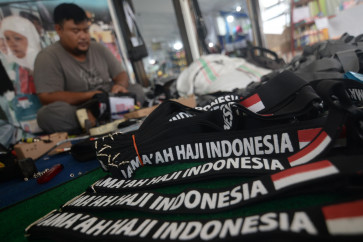Desa Dasun: From Shipping to Marine Tourism
Patience matters: Women workers of a batik factory, Pusaka Beruang in Lasem, Rembang regency, Central Java, are engrossed in making batik
Change text size
Gift Premium Articles
to Anyone

P
atience matters: Women workers of a batik factory, Pusaka Beruang in Lasem, Rembang regency, Central Java, are engrossed in making batik. Patience is highly needed to make batik.
In the past, the village of Dasun (Desa Dasun), Lasem district, Rembang regency, Central Java, was the center for the engineering and construction of big ships. Some village elders even said they had been there when the village had been the production center for big ships when the country was still under the occupation of the Japanese military.
The Japanese chose Desa Dasun to construct their ships as it is situated near the sea. The village is located near the Lasem River that flows through Lasem, which is an old town rich in stories of past glories.
“We realized that our village had the potential for tourism. However, we didn’t have money to develop it. It was in 2015 that the idea to build a tourist village became stronger. Gradually, we went ahead with the plan. We used some of the money from the village fund (from the central government) to build the supporting infrastructure,” Desa Dasun’s village head, Sujarwo, told The Jakarta Post on Sunday.
The shipping industry in Desa Dasun during the Dutch occupation is well documented on media.kitlv.nl. Locals believe that the industry can be traced all the way back to the Majapahit Kingdom of the 14th and 15th centuries.
The village’s rich history is a strong incentive to entice visitors. Moreover, the remains of the shipyards and docks can still be seen. Also, the majority of the villagers are fishermen and many fishing boats can be seen along the shore.
“We take tourists on boat trips on the Lasem River whose other name is the Dasun River. They can go all the way to the sea to enjoy the beautiful sunsets or head to Chinatown in Lasem.
“We also have mangrove forests on the left and right sides of the river and the air is fresh. It’s really alluring,” said Exan Ali, one of the tourist workers in Desa Dasun.
Indonesia’s great writer, Pramoedya Ananta Tour, even mentioned Desa Dasun and its docks in his book, Jalan Raya Pos, Jalan Daendels (2005).
The remains of the docks are still there. In the area, tourists can still find the foundations of three docks. Two pillars can be found on the banks of the Dasun-Lasem River, the other one is at Lasem Beach, which is located about 1 kilometer from the other two.
These three pillars are in the shape of a half ship. They are made of cement cast mixed with stones, gravel and sea sand. The remains of a sluice gate made of teak once stood in the river. However, the teak disappeared few years ago, presumably taken by a villager.
At the time, the people did not understand that it had huge historical value. The gate comprised four teak boards of around 4 square meters set in a line. People said the boards were stolen and sold.
Sujarwo said boat rides on the river was very popular with local tourists.

“In the high season, 500 tourists visit us. We utilize the fishing boats to take them on trips. The cost for one trip is Rp 700,000 (US$48) on a big boat and Rp 500,000 on a small one. More than 10 people can get on one boat, so the price is very affordable,” he added.
Village funds are around Rp 780 million per year and the village administration set aside some of it to build a warung apung (a floating store and restaurant) on the river’s banks. It is managed by a village-owned enterprise and serves various types of food, which are the specialty of the village and the region.
You can find urap latoh, a mainstay in the area. It is a dish made of seaweed with grated coconut and eaten with fish. The taste is specific and certainly delicious.
There are also diverse dishes with milkfish or chicken as the main ingredient. For drinks, tourists can opt for tea, coffee or fruit juice.
Handmade batik
Aside from marine tourism, Desa Dasun also offers trips to the local Chinatown in Lasem. Tourists can get off near Cun An Kiong temple, which is said to be one of the oldest temples on Java Island.
From there, they can proceed to Omah Lawang Ombo (Lawang Ombo House), which is located on Jl. Dasun in the village of Saditan. Lawang Ombo is a big house with Chinese architecture, which was once an opium warehouse.
The house has a tunnel connecting it to the river. Opium would enter Lasem from China and it would then be taken to Lawang Ombo through the underground tunnel.
In Chinatown, there is also a red house that the locals refer to as Little China. It is located in the village of Karangturi. The red house belongs to Rudi Hartono, a rich businessman in Lasem. He had the house renovated and made into a tourist attraction.
In 2016, the villagers in Karangturi established Kelompok Sadar Wisata (the Tourism Awareness Group). The group has been helping to manage the tourism industry in the village, including promoting the red house and, thus, helping to make it into a popular tourist destination.
“With Chinatown in Lasem getting more popular, handmade batik from Lasem has also enjoyed increased popularity. A handmade batik producer reported that his sales doubled because of the impact of tourism,” said Harjono, Kecamatan Lasem’s head.
So, today, visiting Chinatown and shopping for handmade batik are packaged with Desa Dasun tourism.
Lasem has 20 villages, each with their own specialty. “We encourage the village administrations to showcase their village’s tourism potential. To learn to manage the industry, I invited the village heads and staff to a village in Umbul Ponggok, Klaten. There, they learned firsthand how to manage the tourism sector from the management of the popular Umbul Ponggok,” he explained.
Umbul Ponggok is a big natural spring, which has been Klaten’s leading tourist attraction.
In Desa Dasun, villagers are ready to become tourist guides, and for accommodation, tourists can stay at homestays managed by the villagers. “We asked the locals to manage the tourism industry in their own village,” said Sujarwo.

Photos by JP/Suherdjoko









